

Þroski hvolpa frá goti til fullorðinsára
Hvolpur gengur í gegnum mörg þroskaskeið þar til hann verður fullorðinn. Þekking á þessu ferli hjálpar þér að átta þig á hver næringarþörf hans er á hverju þroskaskeiði.
Birth
Birth
Behaviour
At birth, puppies' eyes are closed, so they cannot see. That being said, a puppy will navigate their way to their mother and litter mates using scent and touch for warmth, care and nutrition. Puppies will spend the majority of their time sleeping at this early stage.

Birth
Development
Puppies should be around 1 - 5% of their expected adult weight at birth. Thanks to the nutrition provided by their mother, they will quickly begin to put on weight. How much weight the puppy gains in their first few days is determined by the breed size. Puppies should normally gain around 2 - 4g a day for each kilogram of an adult dog of the same breed.
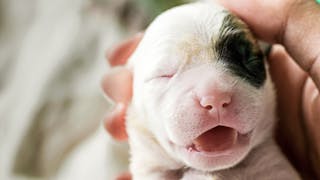
Birth
Environment
In newborn puppies, thermoregulation is not fully mature, so in the first hours it's crucial that they are kept in the right environment. Their whelping box should be kept at between 29.5 - 32°C. After this, temperatures may be gradually decreased to approximately 26.7°C at seven to ten days. The birthing box should also be in a well-aired area that’s not too draughty or stuffy.
Birth
Health
The major challenge of birth for puppies is to became autonomous for breath, heat and feeding to survive to this very critical moment. To support them, it’s important to appropriately prepare the whelping box. Bowls of water or a humidifier should be used to keep the space at 65-70% humidity and foster correct breath, and a radiation or infrared lamp to heat the space.
Almost immediately after birth, a breeder will weigh the puppies to give an outline of their condition and identify any puppies under the expected birth weight. Birth weight and growth rate during the first 48 hours are key parameters for breeders to give an outline of a litter's condition and identify any puppies at risk of neonatal mortality.
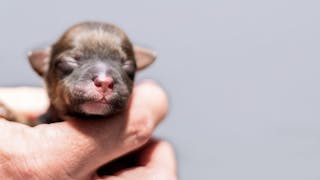
Birth
Nutrition
It's important that puppies suckle as soon as possible after they are born. Rather than ingesting milk, the puppies ingest colostrum, a substance produced by the mother which supports and enhances the puppy’s immune system.
Neonatal
0 - 3 weeks
Behaviour
The majority of a puppy’s life in this first stage of growth is spent feeding or sleeping. This is vital to healthy development, and care should be taken to avoid disturbing the litter or the mother.
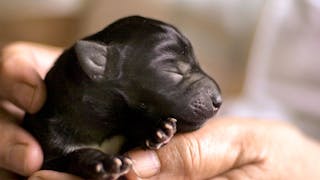
0 - 3 weeks
Development
Puppies’ eyes begin to open 10 to 14 days after birth and during the third week the ears gradually begin to function. Both senses will be weak at first, but will improve as they progress.

0 - 3 weeks
Health
A responsible breeder will ensure that all puppies visit a vet in the early days of life. The vet will check for birth defects and general well-being. Towards the end of this period it is a good idea to start worming treatments.
0 - 3 weeks
Nutrition
After birth, puppies will continue to rely on their mother for the important proteins they need to synthesise. As they grow older, they may start to show interest in their mother's food. With the introduction of solids, the weaning process begins.
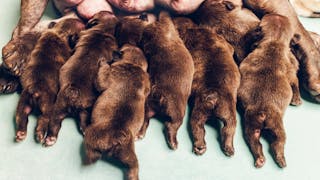
Weaning
4 - 8 weeks
Behaviour
First steps are taken and puppies begin to play fight with their siblings, and may even begin to practice growling and tail-wagging as social interaction begins.

4 - 8 weeks
Environment
A puppy's mental and physical development is aided by a complex environment. A responsible breeder will provide puppies with an increasing amount of human interaction, a range of toys, noise and other stimuli as this stage progresses.

4 - 8 weeks
Health
Puppies should now have begun to pass urine and faeces without their mother's help. If this development doesn’t happen by the end of this stage, a trip to the vet is advised.
4 - 8 weeks
Nutrition
During the weaning period, the mother still provides for all of the puppies' nutritional needs. The vast majority of food is taken through milk, however, at this stage puppies begin to have more interest in their mother's food. Most will now be able to lap water from a bowl.
Puppyhood
8 weeks +
Development
Much of a puppy's height and muscle growth happens between six to nine months, depending on the breed size. Milk teeth are replaced by adult teeth, and an adult coat replaces the puppy coat. Somewhere between six to 12 months your puppy may begin to lift his leg, or enter her first heat period.

8 weeks +
Environment
Ensuring that your puppy has their own set places for eating and sleeping, as well as a range of toys to play with, will help with understanding of basic house rules. Exploring a range of outdoor environments and being exposed to new experiences will stimulate learning, breed self-confidence and generate a stronger bond between puppy and owner.
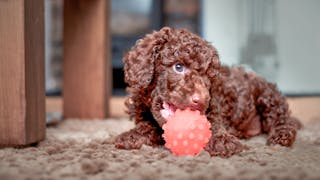
8 weeks +
Health
This is a good time to start to set activity and exercise schedules adapted to your puppy's developmental stage. Getting into good habits now will aid development and set your puppy up for a healthy future. Speak to your vet about a vaccination schedule and whether you should consider spaying or neutering your puppy.
8 weeks +
Nutrition
This is a key stage in the physical development of puppies, so ensuring they are eating food designed to meet the needs of this specific developmental stage is vital. See our puppy nutrition guide for more information, or take a look at our puppy products.
Becoming an adult
12 - 24 months
Development
The growth process for puppies differs depending on their breed size. Extra Small breed dogs can reach full maturity at 8 months, while giant breeds are not considered fully grown until 2 years old.
Up to eight or nine months, large and giant puppies experience rapid skeletal growth, with the remaining months focussing on developing muscle until they reach their adult bodyweight (70 times their birthweight in large breeds and 100 times their birthweight in giant breeds).

Sérsniðin næring fyrir hvolpinn þinn
ROYAL CANIN® hvolpafóðrið eflir vöxt og þroska. Í því eru öll næringarefni sem eru nauðsynleg fyrir hvolpa fyrsta árið.
Rétta fóðrið fyrir hundinn þinn
Blöndurnar okkar fyrir fullorðna hunda veita næringu sem er sniðin að heilsuþörfum hundsins, sama hver stærðin, kynið, aldurinn eða lífsstíllinn er.
Meira lesefni


Hvenær verður hvolpurinn minn fullorðinn?

Hvað á að gefa hvolpafullum hundi að borða og hvernig?
